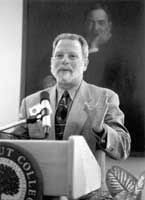|

A
New Year Ahead for New College Presidents
President
Norman Fainstein: Connecticut College
By
Pola Rosen, Ed.D.
(First
of a Series Interviewing New College Presidents Around the Country)
Norman
Fainstein became the President of Connecticut College after many
years as an academic at such distinguished institutions as City
University and Vassar College. Among the varied challenges he
faced were those of 12,000 needy undergrads at City University
who had to divide their time between work, study and commuting.
In contrast, at Vassar, a residential milieu with small classes
and a direct relationship between professor and students prevailed
which enabled students to devote all their energies to academic
life.
These were the two worlds in which Fainstein forged his skills
as an academic leader. Today, Fainstein is excited about being
at a first rate liberal arts college with a global orientation.
The student body reflects the national trend of more females with
over 55% women in attendance.
The changing social demography continues to evolve, according
to Fainstein. “Students of color and immigrants need financial
support. There should be more opportunities for young people to
be integrated into our society,” says Fainstein. “The solution
is more state and federal aid, more scholarship aid and more support
to students. The problem is the cost of higher education; the
government has withdrawn its support.”
In speaking about the state of higher educa-
tion today, Fainstein clearly delineated several important trends.
Colleges have become more competitive and are not as ‘need blind’
as before. The technology revolution is becoming an integral part
of higher education. Fainstein is on the cutting edge of that
technology movement as a member of the national initiative
at Carnegie Mellon which aims to strengthen
technology in liberal arts colleges. Stating that “distance learning
is the least important part of that trend,” Fainstein acknowledges
that “it is important in adult and professional ventures” and
cites the University of Phoenix as being the largest private university
in the country to bring faculty to students. “There is a tremendous
revolution in the way we understand the world.” In the private
sector of higher education, Fainstein opines that our society
exhibits a winner take all mentality. Increasing numbers of students
recognize and reinforce the value of getting into the top 50 colleges.
In describing the current student body at the University of Connecticut,
Fainstein proudly underscores the innovative technology , the
popular majors of biology, English and psychology, environmental
studies and media studies.
In discussing the mentors in his own life, Fainstein cited Robert
Curvin, the dean of the graduate school of management who “brought
me into the New School and Paul LeClerc, the president of the
New York Public Library” as well as Pat McPherson from whom he
learned about leadership styles and moving institutions ahead.
In describing several of the challenges of the college presidency,
dealing with the board of trustees, strategic planning and fund
raising, Fainstein appears admirably suited to the robes of chief
academic.#
Education Update, Inc., P.O. Box 20005, New York, NY 10001. Tel:
(212) 481-5519. Fax: (212) 481-3919. Email: ednews1@aol.com.
All material is copyrighted and may not be printed without express consent of
the publisher. © 2001.
|

